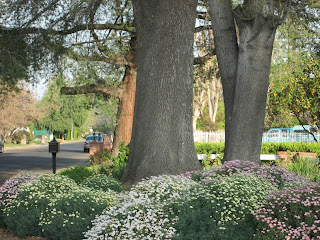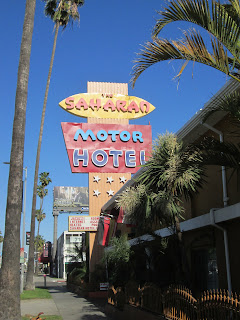Monday, April 29, 2013
Thursday, April 25, 2013
A Culture in Exile
A Culture in Exile - Classical musicians in Hollywood in the 1930s and 40s
 |
| Los Angeles skyline, photo: Navid Serrano |
I visited his son and daughter-in-law, Ronald and Barbara, retired California trial judge and professor of German literature and language respectively, at the Schoenberg family home in Brentwood. Ronald showed me his father’s workspace. When his father worked here, there was a board over the archway (the house is in a Spanish style), so that he could have privacy. There are still things on the desk that reveal little character details about Schoenberg – the box that once housed the chess set Schoenberg made for Ronald, a piece of paper with a method for scoring tennis. You get a sense of the broad creativity of a truly creative person. And you also get a sense of the person behind the monument. Ronald mentions that a visitor to the Schoenberg archive in Vienna objected to footage of Schoenberg laughing and smiling – ‘That shouldn’t be shown’ – but that’s also the Schoenberg the family saw, the smiling person was Dad. Barbara shows me a cabinet containing her composer father, Eric Zeisl’s memorabilia – a letter from Alma Mahler, a letter in French from Igor and Vera Stravinsky saying how shocked they were by Zeisl’s sudden death. She tells me about Zeisl’s radiant Requiem Ebraico. You get the sense that both Schoenbergs would wish for more performances of their parents’ music, but ‘Christian Tetzlaff is playing Schoenberg’s Violin Concerto with the Philharmonic next season’ says Barbara and they’re getting more and more people coming to look at the house these days. Many of them are Austrians or Germans. ‘They hover,’ she says. ‘If I’m out in the garden, I ask them if I can help, and they say, “Oh, no thank you”, and I can tell by the accent, so then I ask in German, and they say, “Is this where the composer Schoenberg lived?”’
Which makes me muse about the lasting legacy of the ‘exiles in paradise’. Certainly, many of the most famous pieces of classical music’s 20th century repertoire were composed in Los Angeles. Not all owe their existence to Los Angeles. But it’s interesting to note that Schoenberg’s Kol nidre, Toch’s Cantata of the Bitter Herbs, Korngold’s A Passover Psalm, Op. 30 and Prayer, Op.32 (the only pieces he composed ‘for myself’ during World War II), and Zeisl’s Reqiuem Ebraico all came about from commissions from Rabbi Jacob Sonderling of the Fairfax Temple. Schoenberg’s Survivor from Warsaw, Ode to Napoleon and String Trio were written in LA. So too, Stravinsky’s Circus Polka, Symphony in Three Movements and Agon. We still experience some of this period’s legacy in film scores of people like John Williams who worked with Franz Waxman and studied with Mario Castelnuovo-Tedesco, or in the concert hall with André Previn who also studied with Castelnuovo-Tedesco. Yuval Sharon, Artistic Director of the opera company, The Industry, credits this period of LA’s history – this period when people like Klemperer and Schoenberg came here, and when UCLA and USC (the University of Southern California) were staffed by people of this quality - with why Los Angeles is so ripe for the sort of artistic experimentation he’s interested in. Because, he says, ‘there’s not just an audience, there’s an amazing audience here that has been developed through what’s already been here culturally.’
This article first appeared in the April 2013 edition of The Podium, the e-newsletter of Symphony Services International.
For another of my articles on German-speakers in a New World environment (this time, Central Australia), see my Victory over death and despair in a bygone age, 5 Nov 2012
Monday, April 22, 2013
Sunday, April 21, 2013
Los Angeles whimsy vi
I love the reminders of the 1920s and the 1940s here, but there is also a lot of terrific modernist architecture.
This reminds me of the style of that Hanna-Barbera cartoon series, The Jetsons. I half expect to hear a chorus singing: "Meet George Jetson..." or seeing 'Jane, his wife' talking to someone on...Wait! Did Hanna-Barbera predict Skype??
This reminds me of the style of that Hanna-Barbera cartoon series, The Jetsons. I half expect to hear a chorus singing: "Meet George Jetson..." or seeing 'Jane, his wife' talking to someone on...Wait! Did Hanna-Barbera predict Skype??
Tuesday, April 16, 2013
The massive amphitheatre
It's a sign synonymous with Los Angeles and represents all the excitement of what happens under it.
 |
| from Vermont Ave, Los Feliz |
But what I find most appealing about this emblazoned "Hollywood" is how visible it is from so many vantage points around the city. It provides me with a criterion by which to define the size of the massive amphitheatre that is the coastal plain backed by Hollywood's hills.
 |
| from Griffith Park Observatory carpark |
 | |||
| from the County Museum of Art, Fairfax District |
Wednesday, April 10, 2013
A walk down Wilshire
We walked to Western Avenue along Wilshire, LA's grand boulevard, starting out in Westlake,
to the other side of Macarthur Park;
passing past deja-vus of Australia;
and grand old buildings along the way
(with more grandeur in the distance).
Some old buildings - thank God - have new uses (Bullocks Wilshire department store now the Southwestern Law School),
but some have been demolished and all that remains is a vague tribute to the building footprint, a poster on a lamp-post,
 |
or old direction to the carpark.
Yes, tragedy struck here, as the poster above says, Senator Robert Kennedy shot on the night of the California Primary, in 1968. Schoenberg's Kol nidre was premiered here too, in 1938, in the Coconut Grove nightclub.
In some places, the charm is provided by 1960s architecture
or echoes of what was there before.
 |
| On the site of the old Wilshire Colonnade |
At least we can be be grateful that in this movie town, many old cinemas remain standing (if not showing films).
Friday, April 5, 2013
Suburbia
Mornin' sun kisses the windows,
Kisses the walls of the little white house;
Kisses the the doorknob, and pretty red roof of the little white house in Scarsdale...
The "Valley" gets such a bad rap ("suburbia"), but so many people try to do something with their own little bit of turf, and sometimes you get beautiful contributions to the streetscape.
If you like my blogs, please vote for Loving Oz and the US in the Australian Writers' Guild's Best Australian Blog competition at:
http://www.surveymonkey.com/s/BAB2013
Kisses the walls of the little white house;
Kisses the the doorknob, and pretty red roof of the little white house in Scarsdale...
- Leonard Bernstein, Trouble in Tahiti
The "Valley" gets such a bad rap ("suburbia"), but so many people try to do something with their own little bit of turf, and sometimes you get beautiful contributions to the streetscape.
 |
| Admittedly not Scarsdale, but still suburbia. Somewhere in the San Fernando Valley |
http://www.surveymonkey.com/s/BAB2013
Subscribe to:
Comments (Atom)

















